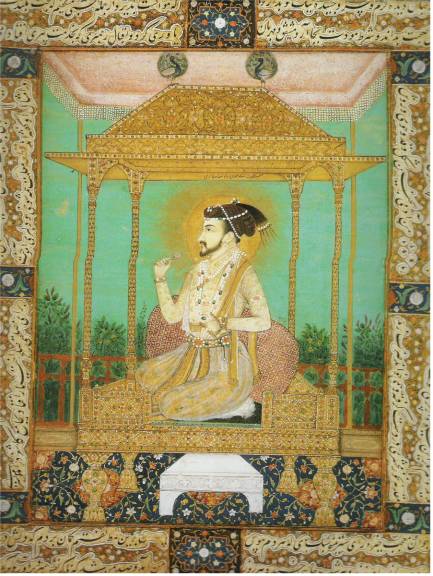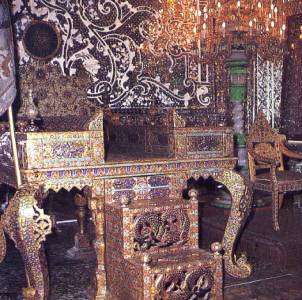|
Austin de Bordeaux, Designer of the Taj Mahal also Designed the Peacock ThroneThe Peacock Throne a jewel of India contained a great accumulation of pearls.  Painting above is of Shah Jahan seated on Throne. Mughal style copy. Collection of Victoria & Albert Museum, London, England. The famous Takht-i-Taus, or "Peacock Throne," at Delhi doubtless contained the greatest accumulation of gems in the seventeenth century. It was completed, in the eighth year of his reign (1044 A..H., 1634 A.D.) by Shah Jehan, greatest of Mogul sovereigns, who likewise built the Taj Mahal at Agra, one of the most beautiful edifices ever designed by man. Abd-al-Hamid, of Lahore, in his Pad=shah-namah, "Book of the King," composed prior to 1654, writes as follows: (Sir Henry Miers Elliot, "The Mohammedan Period as described by Its Own Historians," Vol.V. of "the History of India," ed. by A.V.W.Jackson, New York, 1907, p.324.) In the course of years many valuable gems had come into the imperial jewel-house, each one of which might serve as an ear-drop for Venus or as an adornment for the girdle of the Sun. Upon the accession of the emperor, it occurred to him that, in the opinion of far-seeing men the acquisition of such rare jewels and the keeping of such wonderful brilliants could render but one service, that of adorning the throne of the empire. They ought, therefore, to be put to such a use that beholders might benefit by their splendor and that majesty might shine with increased brilliancy. As described by Tavernier in 1676, great quantities of pearls were used in the ornamentation of this throne, the arched roof, the supporting pillars, the adjacent sun-umbrellas, being well covered with these gems, many of them of great value. The choicest one was pear-shaped, yellowish in color, and weighed about fifty carats (200 grains) (See Fig.2 of Tavernier's diagram.); This was suspended from a great ruby which ornamented the breast of the peacock. "But that which in my opinion is the most costly thing about this magnificent throne is that the twelve columns supporting the canopy are surrounded with beautiful rows of pearls, which are round and of fine water, and weigh from 6 to 10 carats each (24 to 40 grains)." (Tavernier, "Travels in India," trans. by V. Ball, London, 1889, Vol II p. 384.) The total value of the jewels entering into the ornamentation was estimated at 160,500,000 livres or $50,187,500; and the present value of the throne as it stands in the shah's palace at Tehran, whither it was carried by Nadir Shah from the sack of Delhi in 1739, even though divested of many of its most valuable gems, is estimated at $13,000,000. (Benjamin, "Persia," p. 73.) The designer of the throne was Austin de Bordeaux, who also planned the magnificent Taj Mahal. He was named by Shah Jehan, "Jewel-Handed," and received a salary of two thousand rupees a month. The Peacock Throne as recorded by Kunz and Stevenson in 1908 in "The Book of the Pearl."  Peacock Throne in Golestan Palace, Iran Shahanshah Nader Shah invaded the Mughal empire in 1738, and returned to Persia in 1739 with the original Peacock Throne as well as many other treasures taken from the Mughal emperor Muhammad Shah. Since then, the term has come to refer not only to the actual throne, but to the Iranian monarchy itself. After Nader Shah was assassinated in 1747, the original Peacock Throne was destroyed in the chaos that ensued. However, later Iranian thrones were referred to as Peacock Thrones, although they resemble a chair rather than a platform. An example of such a throne is the Naderi throne, built in 1812 for Fath Ali Shah Qajar. Another Iranian throne, built in 1836 for Mohammad Shah Qajar, is also called the Peacock Throne. |











